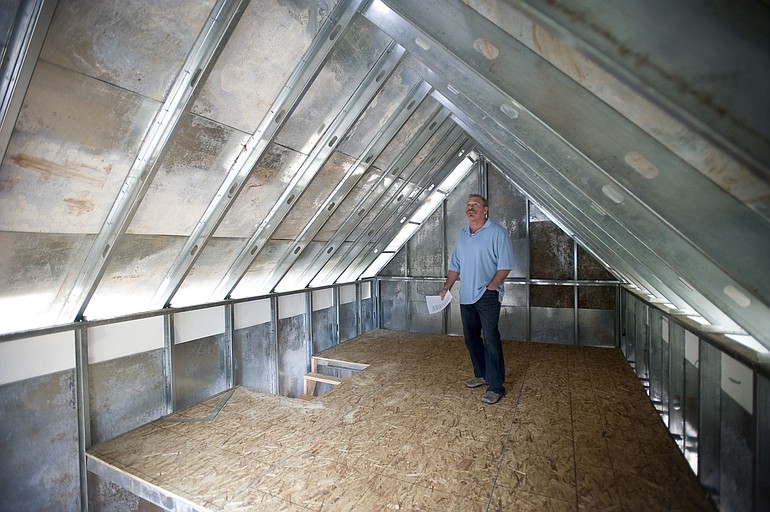Mark Meyers saw news coverage of the earthquakes that ravaged Haiti and Chile in recent months and thought of all people whose homes were destroyed. The Camas resident and owner of Meyers Green Steel Homes recently found what he believes to be the answer in a pile of steel scraps on his family’s nearly 2-acre property.
In five days, Meyers constructed a 540-square-foot steel “smart house” he says would be ideal for providing temporary shelter for families displaced by hurricanes or earthquakes.
It’s cost-effective and completely recyclable, he said. Meyers and his project were featured in a KGW News Channel 8 segment last month.
The structure, which includes a one-room main floor and a loft area, could house a few families, Meyers said. Later, after the urgent need for shelter subsides, it could be recycled or outfitted with a kitchen and bathroom and turned into a permanent home, he added.
Meyers estimates the materials to build such a shelter would cost about $6,000. He’d like to volunteer his time to go to Haiti and Chile with a crew and train people there to build these smart houses, but first he needs material donations. He’s talked to a contact in the steel industry and people who have heard about his model smart house, but so far no one has offered to help.
“Nothing has happened like I thought it would. I thought and a lot of my friends thought I’d be in Haiti right now,” Meyers said. “I know the economy is bad, but people haven’t stepped forward. It’s surprising to me. I was ready to go.”
Meyers, 51, is especially interested in the teaching aspect of his proposed endeavor. A former trainer for the steel manufacturer USS-POSCO Industries, Meyers knows the value of learning a trade. He grew up poor and says he relates to disaster survivors’ worries about basics such as food and shelter.
Meyers’ brother taught him to work with steel as a teen, and he credits that skill with changing the course of his life.
“It made me who I am today,” he said.
Meyers wants to pass that lesson on to people in developing nations displaced by earthquakes and hurricanes, giving them the same opportunity to learn a trade, build self-esteem and forge a future.
“You’re creating framers, you’re creating masons, you’re creating people who are rebuilding their own communities,” he said.
Meyers himself has been a builder for more than 30 years, and has been building steel houses for more than 20 years. About a year and a half ago, he completed a 3,000-square-foot steel addition to the approximately 1,000-square-foot 1930s home he and his wife, Sherry, share with their two children.
The two-story add-on boasts nearly 40-foot ceilings in the living room, and includes three bedrooms, two bathrooms and a game area. Everything structural is steel, and wood is used cosmetically.
To learn more about Mark Meyers’ steel building efforts, click here
Meyers believes steel to be a superior building material because of its strength. It has the highest strength-to-weight ratio of any building material, according to the Steel Framing Alliance Web site. Steel does not rot, mold, warp, split or attract termites, all issues that can affect wood houses, Meyers said. It’s also non-combustible.
Steel is a green choice, as well, supporters say.
“All steel products contain recycled content and can be recycled indefinitely. More steel is recycled on an annual basis than any other material,” said Maribeth Rizzuto, director of education and sustainable construction for the Washington, D.C.-based Steel Framing Alliance.
Meyers said that steel’s durability makes it a good fit for countries prone to earthquakes and hurricanes, but Mehmet Celebi, U.S. Geological Survey structural engineer, says it isn’t that simple. Steel, timber and reinforced concrete can all be used to build earthquake-resistant homes, as long as the design and construction are sound, he said. Engineers must anticipate forces a building might need to withstand, then design accordingly. Which type of building material is best depends on a number of factors including cost and availability, he said.
Design and practical concerns are key, Meyers concurs, but he maintains that steel is best, “hands down.”
Interest increasing
Living Steel, which falls under the World Steel Association umbrella and is an international consortium of steel companies that promotes steel for use in residential construction, has seen interest in steel increase in some countries hit by natural disasters, said Scott Chubbs, program director for the Belgium-based World Steel Association.
Living Steel was contacted by an aid agency working in Haiti and provided it with ideas for transitional steel housing, as well as assistance making connections with steel companies able to help meet the country’s housing needs.
Following the 2008 Sichuan earthquake, Living Steel worked with Chinese member company Baosteel to help introduce permanent, affordable steel housing. Baosteel is now completing an apartment development for almost 1,400 families in a project called Happiness Gardens. Living Steel and Baosteel also are working on individual homes around the city of Dujiangyan. At last count, 13 were completed or under construction, and up to 40 are expected, depending on funding.
Living Steel surveyed public opinion of building materials in Sichuan province after the quake and found steel to be well-received.
“I think this might be as a result of the extreme building failure in the area, and the perception of steel as a strong material,” Chubbs said.
Meyers hopes to find a similar reaction in Haiti and Chile. He’d like to ship steel into those countries to construct his smart homes, should donations and funding allow. He wants to provide people there with the same sense of security he and his family enjoy in Camas.
“I feel really safe living in a structure that’s really strong,” said Sherry Meyers, vice president of Meyers Green Steel Homes. “They build bridges out of steel, and those are supposed to be here forever.”
Mary Ann Albright: maryann.albright@columbian.com, 360-735-4507.



